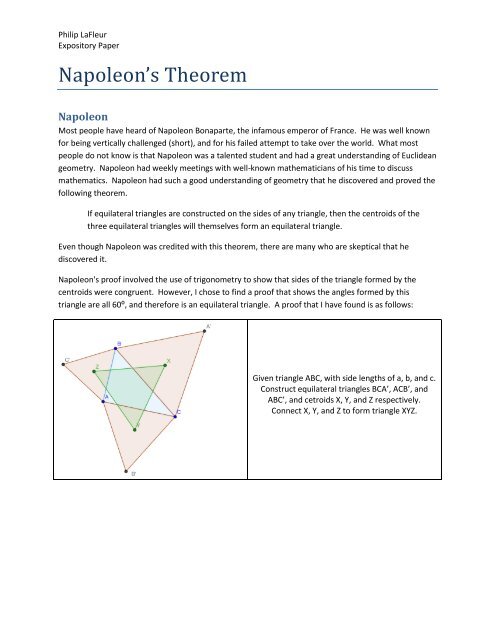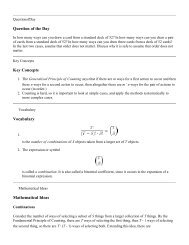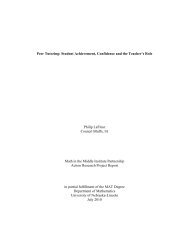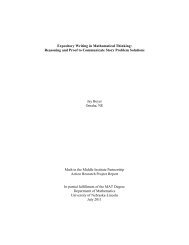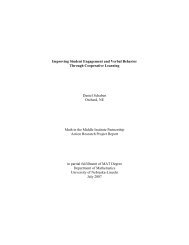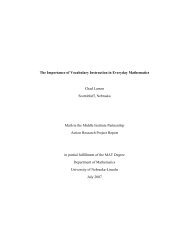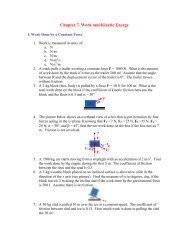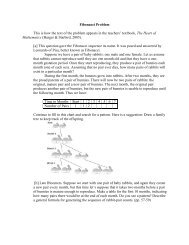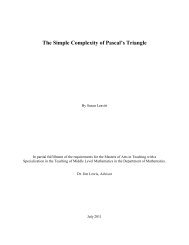Napoleon's Theorem
Napoleon's Theorem
Napoleon's Theorem
Create successful ePaper yourself
Turn your PDF publications into a flip-book with our unique Google optimized e-Paper software.
Philip LaFleur<br />
Expository Paper<br />
Napoleon’s <strong>Theorem</strong><br />
Napoleon<br />
Most people have heard of Napoleon Bonaparte, the infamous emperor of France. He was well known<br />
for being vertically challenged (short), and for his failed attempt to take over the world. What most<br />
people do not know is that Napoleon was a talented student and had a great understanding of Euclidean<br />
geometry. Napoleon had weekly meetings with well-known mathematicians of his time to discuss<br />
mathematics. Napoleon had such a good understanding of geometry that he discovered and proved the<br />
following theorem.<br />
If equilateral triangles are constructed on the sides of any triangle, then the centroids of the<br />
three equilateral triangles will themselves form an equilateral triangle.<br />
Even though Napoleon was credited with this theorem, there are many who are skeptical that he<br />
discovered it.<br />
<strong>Napoleon's</strong> proof involved the use of trigonometry to show that sides of the triangle formed by the<br />
centroids were congruent. However, I chose to find a proof that shows the angles formed by this<br />
triangle are all 60:, and therefore is an equilateral triangle. A proof that I have found is as follows:<br />
Given triangle ABC, with side lengths of a, b, and c.<br />
Construct equilateral triangles BCA’, ACB’, and<br />
ABC’, and cetroids X, Y, and Z respectively.<br />
Connect X, Y, and Z to form triangle XYZ.
Philip LaFleur<br />
Expository Paper<br />
Next, I will connect AA', BB', and CC'. It is known<br />
that these 3 lines intersect at a common point F,<br />
called Fermat's Point. Fermat's Point is the<br />
location where the sum of the distances from the<br />
vertices is the smallest. So Fermat's Point is the<br />
point F that yields the smallest distance for<br />
AF+BF+CF.<br />
In the picture at the left, I have isolated the pieces<br />
of the diagram that I need to show that triangle<br />
C'BC is congruent to triangle ABA'. I know that<br />
AB=BC', BA'=BC, and C'BC=60:+ x = ABA'. Thus,<br />
by side angle side, the two triangles are congruent.<br />
Using the fact that triangle C'FA' is congruent to<br />
triangle ABA', I can discover the measures of the<br />
angles formed by Fermat's Point. I know that<br />
BAA' = BC'C since they are corresponding parts<br />
of congruent triangles and C'EB = AEF since<br />
they are vertical angles. Thus, triangle C'EB is<br />
similar to triangle AEF. This means that C'BE =<br />
AFE. Since C'BE = 60:, then I know that AFE =<br />
60:. This same approach can be done to<br />
determine that<br />
C'FB= BFA'= A'FC= CFB'= B'FA= AFC'=60:.<br />
Next I will construct circumcircles for equilateral<br />
triangles BCA', ACB' and ABC' with centers X, Y,<br />
and Z respectively. Points X, Y, and Z are the<br />
centers for both their respective triangle and<br />
circumcircles. Since triangles ABC', BCA', and ACB'<br />
are equilateral, then triangles AZB, BXC, and CYA<br />
are isosceles with their largest angle being 120:.
Philip LaFleur<br />
Expository Paper<br />
The circles centered at points Z and X intersect at<br />
points B and G. Triangle GZB is isosceles because<br />
and are both the radius of the circle with<br />
center Z and are therefore congruent. If a line<br />
were drawn from point Z to bisect chord BG, it<br />
would split triangle GZB into two congruent<br />
triangles. Since triangle GZB is isosceles, and the<br />
line bisects chord BG forming two congruent<br />
triangles, then this line must also be perpendicular<br />
to chord BG. It follows that if you were to do the<br />
same from point X, that this line too would be<br />
perpendicular to the common chord BG. Thus, the<br />
perpendicular bisector of the common chord BG<br />
must pass through points Z and X. So is<br />
perpendicular to chord BG.<br />
At this point, I must show that point G is in fact the<br />
same as point F (Fermat's Point). It is known that<br />
the Fermat Point is the common intersection of<br />
segment AA’, CC’, and BB’. So we need only show<br />
that G is on the segment AA’. A similar argument<br />
will imply that G is also on segment CC’ and<br />
therefore that G must be the Fermat Point. To<br />
carry this out, notice that the vertices B, C’, A are<br />
equally spaced around the circle, since BC’A is an<br />
equilateral triangle. Thus, BZC' = 120: = arc BC’.<br />
Since point G lies on the same circumcircle, I can<br />
use a theorem and say that BGC' is going to be<br />
half of the measure of arc BC'. Thus, BGC' = 60:.<br />
By the same process, it follows that arc A'B = 120:<br />
and BGA' = 60:.<br />
I will use the same theorem as above to say that<br />
CGA, AGB, and BGC are all equal to<br />
. Since AGB = 120 and<br />
AGB' BGA' = 60:, then B'GB A’GA = 180: and is<br />
therefore a straight line. The same can be done<br />
with C', G, C and B, G, B'. Since all three lines<br />
intersect at point G, then G=F, the Fermat point.
Philip LaFleur<br />
Expository Paper<br />
I have shown that AFB = 120:, is<br />
perpendicular to , and is perpendicular to<br />
. I know that the sum of the angles in<br />
quadrilateral ZHFJ is 360:. So 360: = 90: + 120: +<br />
90: + Z. Thus Z = 60:. The same can be done<br />
for quadrilaterals XIFH and YJFI. Since Z, Y, and<br />
X are all = 60:, triangle XYZ is equilateral. Thus,<br />
proving <strong>Napoleon's</strong> <strong>Theorem</strong>.<br />
<strong>Napoleon's</strong> <strong>Theorem</strong> does not specify whether the equilateral triangles constructed need to be outward<br />
or not. Unfortunately my proof will not hold true if the triangles are constructed inwards. This is due to<br />
the fact that they must be outward in order for Fermat's point to be located. Thus, <strong>Napoleon's</strong> proof<br />
must be used for inward equilateral triangles.<br />
van Aubel<br />
<strong>Napoleon's</strong> <strong>Theorem</strong> can be related to van Aubel's <strong>Theorem</strong>. I was unable to find any information<br />
about van Aubel, even a first name, on the internet. The theorem is as follows:<br />
Given a quadrilateral, place a square outwardly on each side, and connect the centers of squares<br />
on opposite sides. The two lines formed have equal length and are perpendicular to one<br />
another.<br />
Given quadrilateral ABCD, construct outward<br />
squares on each side. Find the centers of squares<br />
ABEF, BCJI, DCLK, and ADHG, and label them N, O,<br />
P and M respectively. Connect the centers of the<br />
opposite squares, forming and . These<br />
segments intersect at point Q.
Philip LaFleur<br />
Expository Paper<br />
Draw a diagonal segment from D to B, forming<br />
. Find the midpoint of , and call it R.<br />
Connect R to the midpoints of two squares on<br />
adjacent sides, forming and . Then<br />
connect points F and D to form triangle FAD. Next<br />
connect points G and B to form triangle GAB.<br />
= since they are sides of square FABE.<br />
= since they are sides of square GADH.<br />
Since and , then<br />
. Then by SAS, triangles FAD and<br />
GAB are congruent.<br />
This means that . Since<br />
are vertical angles, then they<br />
too are congruent. I then know that<br />
and the latter is 90:. Therefore,<br />
. Since is a line and , then<br />
.
Philip LaFleur<br />
Expository Paper<br />
Since N is the midpoint of and point R is the<br />
midpoint of , then by the Midpoint <strong>Theorem</strong>,<br />
is half the length of and parallel to . This<br />
same process can be applied to show that is<br />
half the length of and parallel to . Since<br />
, it follows that .<br />
Since is parallel to , and is<br />
perpendicular to , then it follows that is<br />
perpendicular to . This means that<br />
This same reasoning can be applied to show<br />
that . Since three of the four angles in<br />
quadrilateral STRU are right angles, this means<br />
that .<br />
Thus, and are equal in length and form<br />
right angle MRN.<br />
Now connect the midpoints of the other two<br />
squares to point R. As with before, and<br />
have equal length and form right triangle ORP.<br />
If you form triangles MRO and NRP, by side angle<br />
side, they are congruent to one another. Thus,<br />
is equal to .
Philip LaFleur<br />
Expository Paper<br />
Since corresponding parts of congruent triangles<br />
are congruent, we know that SNR and QMR are<br />
congruent. By the sum of the interior angles of a<br />
triangle, I know that NRS is 90:, so the sum of<br />
RNS and RSN must be 90:. Since SNR and<br />
QMS are congruent, and MSQ and NSQ are<br />
vertical angles, I know that the sum of MSQ and<br />
QMS must also equal 90:. By the sum of the<br />
interior angles of a triangle, Since MSQ + QMS<br />
= 90:, then MQS = 90:. Thus, MQN = 90: and<br />
is perpendicular to . Therefore, the<br />
segments formed by connecting the midpoints of<br />
opposite squares will be both congruent and<br />
perpendicular.<br />
Interesting Extension<br />
While playing around with these theorems, I wondered if there were any other polygons that this would<br />
work for. I tried pentagons and hexagons, but was unable to discover anything noteworthy. The one<br />
thing that I did find interesting I stumbled upon when trying to use van Aubel's theorem to help prove<br />
<strong>Napoleon's</strong>.<br />
I was attempting to show that is<br />
perpendicular to , and thought that<br />
since van Aubel's theorem involves a right<br />
angle being formed, I thought that I might<br />
be able to manipulate things to work in<br />
my favor. I began by taking the picture<br />
from Napoleon, duplicating and rotating<br />
triangle ABC, and formed parallelogram<br />
ABDC.
Philip LaFleur<br />
Expository Paper<br />
Next, I drew the outward squares from<br />
the sides of parallelogram ABDC.<br />
Then I found the midpoints of those<br />
squares and connected them to the<br />
opposite midpoints. From van Aubel's<br />
theorem, I know that these segments are<br />
congruent and are perpendicular to one<br />
another. I realized after looking at the<br />
picture that the segments connecting<br />
adjacent midpoints also form a square.<br />
Using Geogebra, I manipulated the<br />
parallelogram to see if any change in size<br />
would yield something other than a<br />
square. However, I was unable to find<br />
any variances. This makes sense, since<br />
the midpoint of is also the midpoint<br />
of parallelogram ABDC. To prove the<br />
resulting figure is a square, one would<br />
need to show that the diagonals bisect<br />
each other and the result would follow. I<br />
will leave the statement as a conjecture<br />
and invite the reader to arrive at a proof.
Philip LaFleur<br />
Expository Paper<br />
References<br />
Gutierrez, A. (2007, February 14). Van aubel's theorem: quadrilateral with squares. Retrieved from<br />
http://agutie.homestead.com/files/vanaubel.html<br />
A. Bogomolny, <strong>Napoleon's</strong> <strong>Theorem</strong> from Interactive Mathematics Miscellany and Puzzles<br />
http://www.cut-the-knot.org/proofs/napoleon_intro.shtml, Accessed 23 July 2010<br />
A. Bogomolny, <strong>Napoleon's</strong> <strong>Theorem</strong>: a proof by plane tessellation from Interactive Mathematics<br />
Miscellany and Puzzles<br />
http://www.cut-the-knot.org/Curriculum/Geometry/NapTess.shtml, Accessed 23 July 2010<br />
CliffsNotes.com. The Midpoint <strong>Theorem</strong>. 23 Jul 2010<br />
http://www.cliffsnotes.com/study_guide/topicArticleId-18851,articleId-18799.html.


